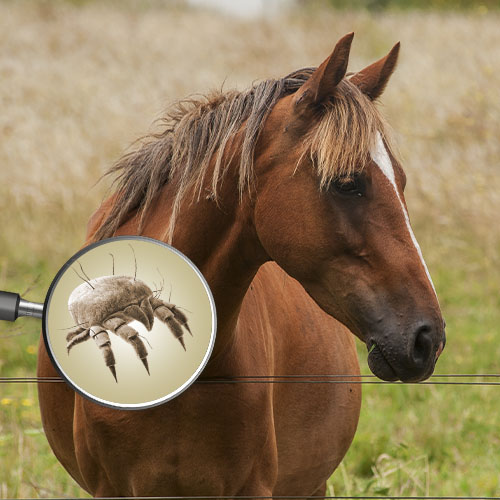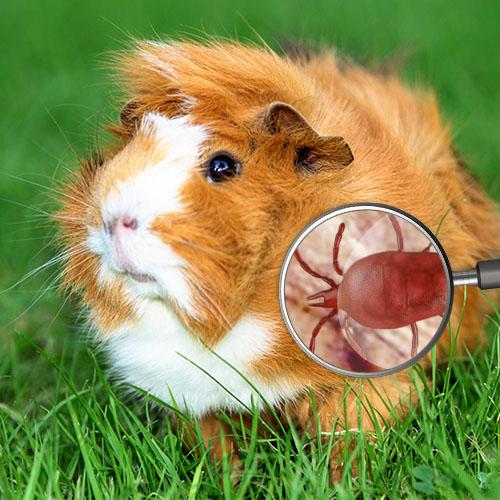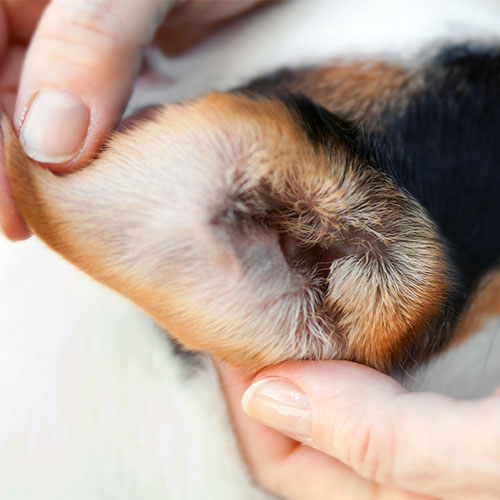Mites

Mites are a class of arthropods that belong to the arachnid family. Around half of the known species live in the soil, but depending on their stage of development and species, they are also able to colonize other habitats. Some live on the skin and feed on skin scales, others live in the skin follicles or deeper layers of the skin and can cause long-lasting and severe skin diseases with more or less severe itching.
As long as the animal has no health problems, the skin is intact as a border organ to the outside world and the infestation is not too large, they pose little health risk.

Mites in horses
Scabies mites can also cause problems for horses. The horse's Sarcoptes mite initially attacks the head, neck and withers and then spreads over the entire body. There is also a Psoroptes mite, which is particularly found in the mane and tail area and spreads over the torso. Both types of mite cause severe itching, similar to dogs and cats, which the horse tries to relieve by rubbing. However, this can allow germs to penetrate the damaged skin and worsen both the skin's appearance and the horse's general well-being.
Fortunately, these types of mite are relatively rare in Germany. The Chorioptes mite causes problems more frequently. It leads to so-called foot mange, particularly in cold-blooded horses and robust breeds with pasterns. It is primarily limited to the lower part of the hind limbs and leads to scabby, and later to greasy and smelly, deposits. The horses are restless, often stamp their legs and chew on themselves.

Mites in pets
Guinea pigs are particularly often infected with mange mites. Sarcoptes mites infect the entire group, but the animals show varying degrees of itching. Animals with weakened immune systems react particularly strongly. As with other animal species, guinea pigs initially develop crusty, hairless patches of skin, which then often become infected. Affected animals become increasingly weaker, lose weight and can eventually die. Immediate treatment of the entire group (including animals that do not scratch themselves) is therefore extremely important!
In addition to guinea pigs, many other small animals such as dwarf rabbits, ferrets, hamsters, rats and mice can also be infected with Sarcoptes mites, but this is somewhat rarer. In rabbits, on the other hand, infestation with ear mites is more common. The rabbits scratch their ears a lot and constantly shake their heads. Nodules and crusty deposits can be seen on the inside of the ears. Ear infections often occur, which further weaken the animal's general well-being. The infection can also break through to the inner ear, which leads to a tilted head and coordination problems. Here too, early cleaning of the ears of mites and mite droppings as part of care has proven to be effective.

Ear mites
Ear mites are special mites that only occur in the auricle and ear canal of dogs or cats. Due to the severe itching, the affected animals often shake their heads, scratch themselves or walk in circles. A black secretion in the ears is noticeable. Scratching can cause open wounds and inflammation, which in severe cases can spread to the internal hearing organs and cause a middle ear infection or even deafness.
For any type of mite infestation
It is particularly important to treat the mites for a sufficiently long period of time, as not all stages of development are usually detected immediately. The surrounding area must also be thoroughly cleaned and, ideally, treated with a natural insecticide, as otherwise the infestation can quickly return.










